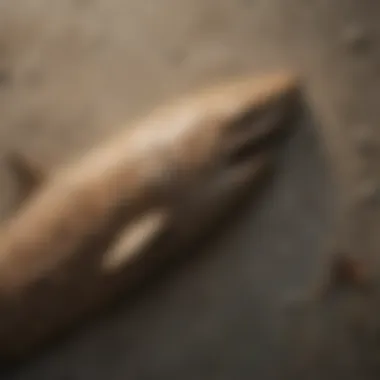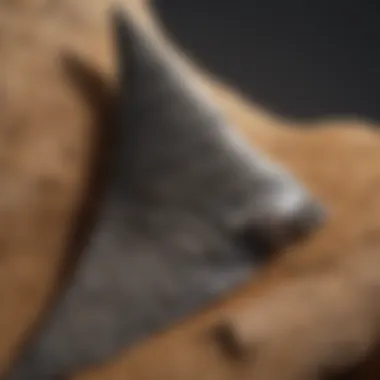Unveiling the Mysteries of Fossilized Sharks: A Dive into Prehistoric Oceans


Rock and Fossil Identification
It is fascinatig to delving into the world of fossilized sharks, more specifically exploring the rocks and fossils that contain these ancient marine creatures. When identifying rocks and fossils that preserve these sharks, one must carefully examine the types of sediments in which they are found. Look for distinct colors, textures, and structures that indicate the presence of well-preserved fossils. Additionally, pay close attention to any imprints or remains of sharks embedded in the rock layers.
To aid in the identification process, various tools can be utilised. These tools include chisels, brushes, and sieves for carefully extracting fossils from the surrounding rock matrix. Using magnifying glasses and UV lights can also help in detecting subtle details that might be missed by the naked eye. Employing these tools effectively enhances the accuracy of fossil identification and ensures that valuable specimens are not damaged during the extraction process.
Collecting Tips and Techniques
For avid collectors interested in fossilized sharks, it is crucial to adhere to best practices for collecting to ensure the preservation and integrity of these ancient artifacts. When embarking on a collecting expedition, research prime locations known for yielding fossilized shark remains. Coastal regions and former seabeds are ideal spots to start the search for these prehistoric treasures. Be sure to obtain any necessary permits before collecting fossils, respecting local regulations and preserving the geological heritage.
When extracting specimens from the rock layers, utmost care must be taken to avoid damage. Use specialized tools such as rock hammers and air scribes to delicately remove fossils from the surrounding matrix while minimizing potential fractures or breakage. Patience is key during the collection process, as rushing can result in irreparable harm to the fossils. Remember, successful collecting is not just about quantity but also about preserving the quality and scientific value of each specimen.
Preservation and Display
After the thrill of collecting fossilized sharks, the next step is to preserve these priceless treasures for future generations to admire and study. Employing proper techniques for preservation is imperative to prevent decay and deterioration of the fossils over time. Methods such as consolidation with adhesives and protective coatings help strengthen fragile fossils and shield them from environmental factors.
When considering how to display these remarkable specimens, creativity plays a significant role. Designing custom frames or shadow boxes that showcase the unique features of each fossilized shark can elevate the presentation. Implementing proper storage methods, such as archival-quality containers and climate-controlled environments, ensures the longevity of the fossils while allowing them to be appreciated for years to come.
Geological Insights
Delving deeper into the study of fossilized sharks offers valuable insights into the geological history of our planet. By examining the rock formations in which these fossils are found, researchers can uncover clues about past environments and the evolution of marine ecosystems. The historical significance of these rocks and fossils extends beyond scientific curiosity, shedding light on the interconnectedness of life through time.
Through notable discoveries in the field of paleontology, such as complete shark skeletons or exceptionally preserved specimens, new understandings of prehistoric marine life can emerge. These discoveries not only contribute to scientific knowledge but also spark the imagination and wonder of enthusiasts and scholars alike. By exploring geological insights related to fossilized sharks, we unravel layers of Earth's history and gain a deeper appreciation for the mysteries preserved in stone.
Introduction to Fossilized Sharks
In the domain of paleontology, the introduction to fossilized sharks encapsulates a realm of profound historical narratives that provide pivotal insights into the evolution of these enigmatic creatures. The section delves deep into elucidating the processes of fossilization that have preserved sharks from ancient epochs, allowing us to unravel the mysteries of their past and comprehend the intricacies of evolution. Through a meticulous examination of fossilized shark remains, researchers and enthusiasts are bestowed with a gateway to the bygone eras of marine life, offering a unique vantage point to study the adaptations and environmental influences that have shaped the lineage of sharks over millennia. The importance of this section lies in its ability to bridge the gap between past and present, fostering a deeper understanding of the biological frameworks that define modern shark species and their evolutionary trajectories.
Understanding Fossilization
The Process of Fossil Formation


Exploring the process of fossil formation unveils a captivating saga of mineralization and organic decay, wherein the gradual replacement of biological tissues with mineral substances facilitates the preservation of ancient organisms. This intricate metamorphosis not only immortalizes prehistoric beings but also provides scientists with crucial data to reconstruct ancient ecosystems and decipher evolutionary patterns. The inexplicable beauty of fossil formation lies in its ability to capture fleeting moments in time, offering us glimpses of long-extinct creatures in their primordial splendor. While the process is inherently delicate and subject to various geological phenomena, its significance in paleontological studies cannot be overstated.
Factors Affecting Fossilization
The multifaceted nature of fossilization is intricately intertwined with a myriad of factors that influence the preservation of organic remnants. From environmental conditions to burial depths, each element plays a crucial role in determining the fidelity and quality of fossilized specimens. These influencing factors act as silent guardians of the past, orchestrating the intricate dance of fossilization that culminates in the preservation of ancient life forms for posterity. While the complexities of fossilization present challenges to researchers, they also bestow invaluable opportunities to unravel the mysteries of bygone eras and glean insights into the evolution of life on Earth.
Preservation of Soft Tissues
Preserving soft tissues within fossilized remains is a rare phenomenon that enriches the scientific community with unparalleled glimpses into the anatomical intricacies of ancient organisms. The remarkable preservation of soft tissues offers researchers a window into the physiological adaptations of prehistoric creatures, shedding light on their biological functions and evolutionary strategies. While the fragility of soft tissues poses significant challenges to preservation, their unique ability to endure the ravages of time provides a treasure trove of information for paleontologists and biologists alike. The preservation of soft tissues stands as a testimony to the resilience of life throughout millennia, encapsulating a delicate balance between decay and immortality within the annals of fossilization.
Evolutionary Insights
Adaptations of Ancient Sharks
Exploring the adaptations of ancient sharks unveils a tapestry of evolutionary marvels that have shaped the survival strategies of these apex predators through geological epochs. From serrated teeth to hydrodynamic body forms, each adaptation speaks volumes about the evolutionary arms race that has driven the diversity and success of shark species over millions of years. The adaptations of ancient sharks stand as testaments to the eons-old battle for supremacy in marine ecosystems, highlighting the intricate dance between predator and prey that has sculpted the physical and behavioral traits of these legendary creatures.
Transition from Cartilaginous to Bony Skeletons
The transition from cartilaginous to bony skeletons marks a pivotal milestone in the evolutionary history of sharks, signifying a shift towards increased skeletal robustness and mineralization. This transformation reflects the adaptive responses of sharks to changing environmental pressures and ecological dynamics, showcasing the resilience and versatility of these ancient predators in the face of evolutionary challenges. The emergence of bony skeletons among shark species opens a window to the past, revealing the underlying mechanisms that have guided the diversification and proliferation of sharks across the world's oceans.
Impact of Environmental Changes
The impact of environmental changes on shark evolution underscores the dynamic interplay between biological adaptation and external forces that shape the fate of species over time. From shifting oceanic currents to fluctuating temperature regimes, environmental changes have exerted profound influences on the evolutionary trajectories of sharks, molding their evolutionary paths and diversification patterns. The resilience of sharks in the face of environmental upheavals sheds light on their adaptive capabilities and underscores the interconnectedness between organisms and their ever-changing habitats, offering invaluable lessons for understanding the intricate dance of life on Earth.
Significance in Paleontology
Contribution to Understanding Prehistoric Ecosystems
The contribution of fossilized sharks to understanding prehistoric ecosystems transcends mere glimpses into the past, offering researchers a holistic view of ancient environmental dynamics and species interactions. By studying fossilized shark remains, paleontologists can reconstruct the intricate webs of life that characterized prehistoric oceans, unraveling food chains, ecological niches, and evolutionary relationships that have sculpted marine biodiversity over epochs. The significance of this contribution lies in its ability to bridge the temporal gap between past and present, fostering a deep appreciation for the interconnectedness of life forms and the delicate balances that sustain ecosystems throughout geological time.
Indicators of Climate Change
Fossilized sharks serve as invaluable indicators of climate change, bearing witness to the subtle shifts in environmental conditions that have shaped the evolutionary trajectories of species across millennia. By examining the isotopic compositions and elemental signatures preserved within fossilized shark tissues, researchers can infer past climatic regimes and unravel the impacts of global environmental changes on marine ecosystems. The insights gleaned from these analyses not only enhance our understanding of past climates but also provide crucial data for modeling future climate scenarios and predicting the potential responses of marine organisms to ongoing environmental shifts.


Insights into Megalodon Evolution
Exploring insights into Megalodon evolution offers a glimpse into the evolutionary saga of one of the largest predators to have roamed the oceans, unraveling the mysteries of its rise and fall through geological time. By studying fossilized Megalodon remains, researchers can piece together the puzzle of this apex predator's adaptations, behaviors, and ecological roles, shedding light on the factors that contributed to its dominance and eventual extinction. The insights garnered from Megalodon evolution not only enrich our understanding of past marine ecosystems but also offer valuable lessons for the conservation and management of contemporary shark species, underscoring the importance of paleontological research in informing conservation strategies and promoting environmental awareness among global audiences.
Types of Fossilized Sharks
Exploring the different types of fossilized sharks is a pivotal aspect of understanding the prehistoric world. Diving into the realm of prehistoric shark species allows us to grasp the immense diversity that once roamed the ancient oceans. Fossilized remains of sharks like the Megalodon, Helicoprion, and Dunkleosteus provide crucial insights into their anatomy, behavior, and evolutionary adaptations. By examining these fossils, scientists can piece together the puzzle of shark evolution and unravel the mysteries of ancient marine ecosystems.
Prehistoric Shark Species
Megalodon
Megalodon, a formidable prehistoric shark, captures our imagination with its sheer size and power. This colossal predator dominated the seas millions of years ago, showcasing the apex predator characteristics that intrigue researchers and enthusiasts alike. With its massive serrated teeth, Megalodon possessed a fearsome hunting prowess that set it apart from other ancient sharks. The rarity of well-preserved Megalodon fossils adds to the enigma surrounding this magnificent creature, making it a focal point for studying prehistoric marine life.
Helicoprion
Helicoprion, known for its unique spiral-toothed jaw apparatus, presents a fascinating puzzle for paleontologists. This peculiar feature sets Helicoprion apart from conventional sharks, sparking debates and theories about its feeding habits and evolutionary niche. Despite the challenges in interpreting Helicoprion fossils, the insights gained from studying this enigmatic creature shed light on the diversity of ancient shark species and the adaptations that shaped their existence.
Dunkleosteus
Dunkleosteus, an armored fish with formidable jaws, paints a vivid picture of ancient marine ecosystems. With its plated armor and massive size, Dunkleosteus symbolizes the apex predators of its time, showcasing an evolutionary arms race that defined prehistoric oceans. The fossilized remains of Dunkleosteus provide valuable clues about the interactions between different species and the roles they played in maintaining ecological balance.
Rare Fossil Finds
Complete Shark Skeletons
Discovering complete shark skeletons in the fossil record offers a treasure trove of information for paleontologists. These well-preserved specimens provide detailed insights into the anatomy, growth patterns, and evolutionary relationships of ancient sharks. By studying complete shark skeletons, researchers can reconstruct the morphology and behavior of these species with remarkable accuracy, enhancing our understanding of past marine environments.
Fossilized Teeth and Jaw Structures
Fossilized teeth and jaw structures offer vital clues about the feeding habits and ecological roles of ancient sharks. These well-preserved dental remains provide direct evidence of the diets and prey preferences of prehistoric sharks, allowing researchers to infer their place in the marine food chain. By analyzing fossilized teeth and jaw structures, scientists can unravel the complex interactions between different shark species and their impact on ancient marine ecosystems.
Imprints of Shark Skin


Imprints of shark skin found in fossilized remains provide valuable information about the appearance and texture of ancient sharks. These impressions offer insights into the scales, dermal denticles, and color patterns of prehistoric sharks, enabling scientists to reconstruct the external morphologies of these creatures. By examining imprints of shark skin, researchers can infer the camouflage strategies, thermoregulatory adaptations, and evolutionary trends that shaped the diversity of shark species throughout history.
Discovery and Excavation
Fossilized sharks are enigmatic creatures from the past, offering invaluable insights into ancient marine ecosystems. The exploration of fossilized shark remains plays a pivotal role in piecing together the puzzle of prehistoric oceans. By unearthing these fossilized relics, scientists can unravel the mysteries of shark evolution and adaptation over millennia. This section delves into the essential processes of discovery and excavation, shedding light on the methods and challenges involved in unearthing these fascinating remnants.
Unearthing Fossilized Remains
In the hunt for fossilized shark remains, one crucial aspect lies in finding shark fossils within marine sediments. This specific exploration aids in understanding the geological context in which these ancient creatures thrived. Finding these remnants embedded in marine sediments provides key information on the habitats and distribution of prehistoric sharks, contributing significantly to our overall comprehension of past environments. The unique feature of uncovering shark fossils in marine sediments is its ability to offer a direct glimpse into the marine ecosystems of bygone eras, enhancing our understanding of ancient shark species and their ecological niches.
Excavation techniques in paleontological sites are meticulous processes crucial for unearthing and preserving delicate fossils. The careful extraction of fossilized remains from various sedimentary layers requires precision and expertise to ensure minimal damage during excavation. These techniques not only enable the retrieval of intact fossils but also document the surrounding geological deposits, aiding in reconstructing paleoenvironments accurately. The advantage of utilizing advanced excavation techniques lies in the preservation of crucial contextual information, allowing scientists to piece together the puzzle of ancient ecosystems with greater accuracy.
Challenges arise when preserving fragile fossil specimens, posing a significant hurdle in maintaining the integrity of these ancient relics. The delicate nature of some fossilized remains demands specialized care to prevent deterioration or damage during handling and storage. Preserving these specimens intact is essential for future research and examination, emphasizing the significance of implementing precise conservation practices. While the challenges of preserving fragile specimens are substantial, overcoming these obstacles is imperative in safeguarding invaluable remnants of our planet's distant past, ensuring their availability for continued scientific study and exploration.
Scientific Analysis and Research
Carbon dating of shark fossils offers a glimpse into the temporal aspects of ancient shark species, helping researchers establish accurate timelines of their existence. This scientific method relies on measuring the decay of carbon isotopes within fossils to determine their age, providing crucial insights into the chronology of shark evolution. Carbon dating is a popular choice in paleontological research due to its reliability and ability to date fossils with remarkable precision.
Microscopic examination of fossil structures allows researchers to delve into the minute details of ancient shark remains, unveiling hidden anatomical features and evolutionary adaptations. This detailed analysis reveals intricate structures that may not be visible to the naked eye, offering a deeper understanding of prehistoric shark biology and morphology. By scrutinizing fossil structures at a microscopic level, scientists can extract invaluable data on ancient shark species, enriching our knowledge of their evolution and diversification.
Comparative studies with modern shark anatomy provide a comparative framework for understanding the remarkable adaptations and variations within the shark lineage. By juxtaposing fossilized shark remains with extant shark species, scientists can trace evolutionary changes across millennia. This comparative approach aids in identifying key evolutionary patterns and anatomical differences, highlighting the long-term adaptations that have shaped modern shark biodiversity. Through comparative studies, researchers bridge the gap between past and present, unraveling the evolutionary tapestry of sharks with meticulous detail and analytical rigor.
Implications for Modern Science
In the realm of modern science, the study of fossilized sharks holds profound significance. One of the key aspects propelling this significance is the insights it provides into the evolution of these enigmatic creatures. By examining the fossil record, scientists are able to trace the lineage of sharks, gaining valuable knowledge about their evolutionary journey over millions of years. This information not only enhances our understanding of the past but also provides crucial context for interpreting the diversity of present-day shark species. Moreover, genetic studies based on fossil evidence offer a unique opportunity to delve into the genetic makeup of ancient sharks, shedding light on their adaptations and genetic variability. Through comprehensive comparative studies between fossilized specimens and contemporary shark species, researchers can discern patterns of long-term adaptations and genetic relationships, contributing significantly to the field of evolutionary biology.
Insights into Shark Evolution
Connections to Contemporary Shark Species
When it comes to exploring the connections between fossilized sharks and contemporary shark species, one cannot overlook the meticulous analysis of anatomical similarities and differences. By examining the structures of ancient shark fossils alongside those of modern sharks, researchers can identify shared characteristics and evolutionary adaptations that have persisted through millennia. This comparative approach enables scientists to make inferences about the evolutionary pathways of various shark lineages, unraveling the complexities of adaptation and survival strategies in different environments. Understanding these connections provides a comprehensive view of shark evolution, highlighting the persistence of certain traits and the emergence of new features over time. Such insights not only enrich our knowledge of shark biodiversity but also offer valuable lessons for conservation and management practices.
Genetic Studies Based on Fossil Evidence
Genetic studies based on fossil evidence offer a unique window into the evolutionary history of sharks. By extracting genetic material from well-preserved fossilized remains, scientists can conduct DNA analysis to uncover crucial information about ancient shark populations. This approach allows researchers to trace genetic lineages, identify mutations, and explore the genetic diversity present in prehistoric shark species. The information gleaned from genetic studies provides valuable insights into the adaptive capabilities of sharks in response to environmental changes and selective pressures. Moreover, it offers a platform for studying genetic stability, population dynamics, and the genetic basis of key adaptations in sharks across different time periods. Through a combination of paleogenomics and comparative genomics, genetic studies based on fossil evidence contribute significantly to our understanding of shark evolution and provide a genetic roadmap of past biodiversity.
Understanding Long-Term Adaptations
Investigating the long-term adaptations of fossilized sharks offers a tantalizing glimpse into the evolutionary strategies that have shaped shark diversity. By analyzing the anatomical features and specialized structures preserved in fossilized remains, researchers can infer the evolutionary pressures that influenced the development of these adaptations. These long-term adaptations encompass a range of traits, including tooth morphology, fin shapes, body size variations, and sensory organs, each reflecting specific evolutionary advantages selected over time. Understanding the mechanisms behind these adaptations not only elucidates the survival strategies of ancient shark species but also sheds light on the processes driving biological diversification and ecological interactions. By deciphering the evolutionary trajectories of fossilized sharks, scientists gain critical insights into the resilience and plasticity of shark populations across changing environmental landscapes, enhancing our appreciation of their adaptive prowess and biological success.







